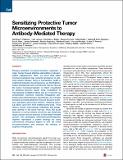Sensitizing Protective Tumor Microenvironments to Antibody-Mediated Therapy
Author(s)
Pallasch, Christian; Leskov, Ilya B.; Vorholt, Daniela; Drake, Adam; Bent, Eric H.; Schwamb, Janine; Iliopoulou, Bettina P.; Kutsch, Nadine; van Rooijen, Nico; Frenzel, Lukas P.; Wendtner, Clemens M.; Heukamp, Lukas; Kreuzer, Karl Anton; Hallek, Michael; Chen, Jianzhu; Braun, Christian Joerg; Soto Feliciano, Yadira Marie; Hemann, Michael; ... Show more Show less
DownloadChen_Sensitizing protective.pdf (2.651Mb)
PUBLISHER_POLICY
Publisher Policy
Article is made available in accordance with the publisher's policy and may be subject to US copyright law. Please refer to the publisher's site for terms of use.
Terms of use
Metadata
Show full item recordAbstract
Therapy-resistant microenvironments represent a major barrier toward effective elimination of disseminated malignancies. Here, we show that select microenvironments can underlie resistance to antibody-based therapy. Using a humanized model of treatment refractory B cell leukemia, we find that infiltration of leukemia cells into the bone marrow rewires the tumor microenvironment to inhibit engulfment of antibody-targeted tumor cells. Resistance to macrophage-mediated killing can be overcome by combination regimens involving therapeutic antibodies and chemotherapy. Specifically, the nitrogen mustard cyclophosphamide induces an acute secretory activating phenotype (ASAP), releasing CCL4, IL8, VEGF, and TNFα from treated tumor cells. These factors induce macrophage infiltration and phagocytic activity in the bone marrow. Thus, the acute induction of stress-related cytokines can effectively target cancer cells for removal by the innate immune system. This synergistic chemoimmunotherapeutic regimen represents a potent strategy for using conventional anticancer agents to alter the tumor microenvironment and promote the efficacy of targeted therapeutics.
Date issued
2014-01Department
Massachusetts Institute of Technology. Department of Biology; Koch Institute for Integrative Cancer Research at MITJournal
Cell
Publisher
Elsevier
Citation
Pallasch, Christian P., Ilya Leskov, Christian J. Braun, Daniela Vorholt, Adam Drake, Yadira M. Soto-Feliciano, Eric H. Bent, et al. “Sensitizing Protective Tumor Microenvironments to Antibody-Mediated Therapy.” Cell 156, no. 3 (January 2014): 590–602. © 2014 Elsevier Inc.
Version: Final published version
ISSN
00928674
1097-4172